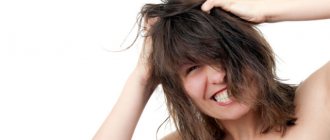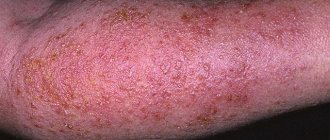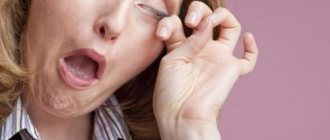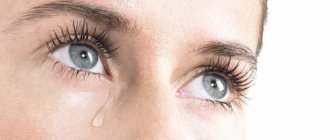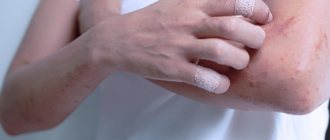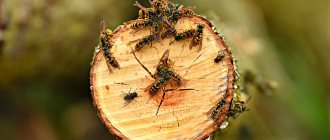Eczema is a type of dermatosis, a skin disease that can affect any part of the body. Very often found in the form of seborrheic eczema on the scalp in the hair. The pathology is not contagious and most often occurs in a chronic form. Eczema can occur in people of any age and gender. From the scalp, dermatitis very quickly spreads to the forehead, neck, as well as the eyebrows and eyelids. The disease requires special drug treatment.
Eczema of the scalp: causes
Eczema that affects the scalp is also called seborrheic. The disease is not contagious and has an infectious-allergic nature of origin. The reasons for the development of pathology may depend on the environment or internal changes in the body.
External risk factors:
- the use of masks or other cosmetics for the scalp containing alcohol;
- prolonged or uncontrolled use of hormones or antibiotics;
- development of allergies to hair dye;
- unfavorable environment;
- using inappropriate shampoos, conditioners or conditioners.
Itching, peeling of the skin and rashes appear.
To cure a disease, it is important to correctly determine the underlying cause of its development. Internal risk factors:
- heredity;
- vitamin deficiency (due to poor nutrition);
- hormonal imbalance;
- increased sweating of the scalp;
- sudden weight gain;
- frequent stressful situations;
- certain diseases (kidney failure or diabetes);
- disruptions in the gastrointestinal tract and immune system.
Before starting treatment, the doctor prescribes a diagnosis that will help determine the provoking factor. Seborrheic eczema often occurs due to several causes simultaneously.
Wen and purulent pimples on the head in men
Wen and purulent pimples on the back of the head can appear in women, even in children, but men are most often affected. This happens for several reasons:
- hormonal disorders;
- improper care;
- failure to comply with hygiene rules;
- stress, depression, overexertion;
- poor nutrition.
Many people are interested in one question: why wen and pimples appear more often in men. It's simple: a substance produced by sweat and sebaceous glands can create a hydrolipid film. This film protects the skin from microorganisms and bacteria. But if it is damaged, microbes easily penetrate the skin and contribute to inflammation. In men, the hydrolipidic membrane is not as strong as in women, which is what contributes to frequent infection.
Causes
Like other similar diseases, eczema on the head does not have exact causes. It is impossible to say unequivocally what provoked such a reaction, but despite this, experts still identify the reasons that contribute to the development of eczema on the head:
- weakened immune system;
- high secretion of sebaceous glands;
- chronic diseases;
- genetic features.
Sometimes scraping results indicate the presence of fungus or streptococcus. But despite this, a fungal infection is a consequence of eczema, not a cause.
How to get rid of the disease
Wen and pimples on the head cause a lot of inconvenience and problems, so a person should get rid of this disease as soon as possible. First of all, you need to take the necessary tests and determine the cause of the disease, and only then begin therapeutic actions. Treatment methods depend on the extent and severity of the rash. When one pimple appears, there is no need to panic, but if the number is constantly increasing, there is no need to postpone going to the doctor.
Tar oil is often used for treatment. It helps cleanse the skin, improves blood circulation and helps get rid of acne and wen. In severe cases, the patient is prescribed special antibacterial ointments. They also do salt baths and rinses with herbal infusions. Salt baths will help men get rid of acne; they have an analgesic, anti-inflammatory and antiseptic effect.
Don't forget about preventive measures. To prevent the appearance of acne and wen you need:
- Avoid stressful situations.
- To refuse from bad habits.
- Protect your skin with hats.
- Review your diet.
When pimples appear, squeezing them is strictly prohibited, as this will increase the possibility of infection.
How is eczema in the hair treated?
The doctor prescribes medications for home treatment, taking into account the symptoms and the cause that contributed to the development of the pathology.
Therapy involves the use of external medications, as well as taking pills to eliminate certain causes.
Crema
Apply directly to affected areas several times a day. The active substance quickly penetrates the layers of the epidermis and begins to work immediately.
Popular creams include:
- Nizoral is a synthetic product that is intended for topical treatment of eczema symptoms. Terbizil is the main substance aimed at preventing the activity of pathogenic fungi.
- Atoderm is a dermatological remedy to eliminate itching, inflammation and flaking. The cream effectively soothes inflamed and irritated skin and moisturizes it well.
- Fundizol is an antifungal drug. The main action is to remove the fungal infection. Contains salicylic acid, celandine and oak bark extract.
- Terbizil is an antimycotic cream with the active substance terbinafine. Fights fungus, reduces itching, dryness and flaking.
- Sudocrem - designed to restore damaged skin affected by eczema. It has many contraindications, so it is important to read the instructions before treatment.
The duration of treatment with each drug will depend on the severity of the lesion. Apply the cream in a very thin layer, do not rinse off.
Shampoos
Even before going to the dermatologist, you can use medicated shampoo when the first symptoms appear.
Before purchasing, you should carefully study the instructions for use and composition. Among the medicated shampoos to combat eczema are:
- Tar shampoo. Contains birch tar, the action of which is aimed at normalizing sebum secretion.
- Sebazol. Antifungal shampoo based on ketoconazole. Reduces itching, flaking of the skin, fights fungal activity.
- Friederm-zinc. The composition includes zinc, which dries the skin and effectively eliminates itching and flaking. It is important to shake the bottle before use.
- Cynovitis. Suppresses fungal activity and reduces itching. Effectively heals scratched wounds.
- Nizoral. The active substances in medicinal shampoo can destroy the cellular structure of microorganisms.
Medicinal shampoos should replace ordinary ones during treatment.
Masks
In combination with taking pills and using pharmaceutical products for external use, you can use homemade masks based on safe natural ingredients.
Effective recipes:
- Grind the onion to a paste. Add 2 tsp. dry mustard (diluted to a paste with water), 1 tbsp. aloe juice and 1 tbsp. honey Mix and apply to affected areas. After an hour, wash off.
- Mix 2 tbsp. vodka, cedar oil and strong brewed black tea. Apply onto the head with light massage movements. Leave for 1.5-2 hours.
- In a blender bowl or using a meat grinder, chop 1 onion and 5 cloves of garlic. Apply the resulting mass to your head. Leave under a warm towel for 25 minutes. Wash off with medicated shampoo.
- In a bowl, mix 25 g lemon juice (freshly squeezed), 25 g garlic juice, 15 ml olive oil. Leave the homogeneous mass on the affected areas for 33-35 minutes. Wash off with the prescribed medicated shampoo. Rinse your hair with vinegar solution.
- Grate 20 g of tar soap on a fine grater. Add 2 tsp. olive or almond oil, 1 yolk and 1 tsp. honey Place in a water bath and heat until the mass is homogeneous (without lumps). Lubricate your scalp. Wait 40 minutes. Rinse under running water with medicated shampoo.
The listed homemade masks should be used 2 times a week. The duration of treatment will continue until the symptoms of seborrhea disappear.
You can resort to using traditional recipes only if there are no allergic reactions to the composition of the mask.
Daily care products
At the first manifestations of eczema on the scalp, you can try to get rid of it with medicated shampoos. In further treatment, shampoos form part of a comprehensive treatment. They are divided into groups according to the direction of action and composition:
- antifungal or antimycotic (Sebozol, Nizoral, Mycozoral);
- tar, which includes birch tar, which regulates the amount of sebum secreted and also destroys pathogenic microorganisms (Algopix, Friederm Tar);
- cosmetic shampoos help eliminate dandruff and flaking (Sulsena, Ecoderm);
- Children's skin care products are also good because most of them are made from natural ingredients that do not cause allergies.
Any shampoo is applied according to the attached instructions. The affected areas are treated carefully so as not to injure the skin.
Most shampoos can be used for preventive purposes, so during remission it is advisable to alternate an ordinary hygiene product with a therapeutic one.
How to treat with tablets
The use of tablets during the treatment of eczema on the hair will help strengthen the immune system, stabilize the functioning of the nervous system and eliminate the allergic cause of the disease.
- When seborrheic eczema develops, it is important to restore the functioning of the immune system. To strengthen the body's defenses, the following drugs have shown good results: Myelopid, Lykopid.
- Antihistamines are needed to eliminate possible somatic causes of pathology. Medicines that can be prescribed: Glycine, Diprazine, Phenibut, Tenoten.
- To combat fungal infection and visible symptoms, doctors recommend Nizoral, Ketoconazole, Zinerit, Fluconazole.
- If during the development of seborrhea there is a malfunction of the gastrointestinal tract, then you will need enzymatic tablets: Mezim or Pancreatin.
- To calm the nervous system, sedatives will help: Persen, Valerian, Novo-passit.
In order not to harm the body, the prescribed drug should be taken according to the instructions or advice of the attending physician.
Prevention
Unfortunately, if a disease appears once, it will accompany a person throughout his life.
To prevent the re-development of symptoms of eczema on the scalp, you need to follow simple preventive measures. These include:
- healthy sleep (at least 7 hours);
- maintaining proper nutrition;
- use of high-quality hair washing products;
- avoiding stress;
- refusal to visit public swimming pools and saunas;
- exclusion of allergenic foods from the diet.
When the first signs of illness appear, you should immediately seek help from medical professionals. Timely treatment will bring about a speedy recovery and stop the development of the disease at an early stage.
Forecasts
For those patients who immediately began using the prescribed medications and following all the dermatologist’s recommendations, the prognosis is comforting.
Treatment will require a lot of patience, diligence and strength from the patient.
Properly selected products will not leave any signs of disease on the scalp.
The neglected condition is fraught with the fact that the rash spreads to the eyelids, forehead and neck. Complications lead to the development of blepharitis (the upper eyelids become inflamed and vision deteriorates).
Hair eczema is a chronic disease characterized by unpleasant symptoms that cause great discomfort. Self-medication can aggravate the course of the disease and lead to unpleasant consequences.
Diagnostic methods
As a rule, a dermatologist can make an appropriate diagnosis for a patient based on only one visual examination.
For more detailed diagnostics:
- a scraping is taken to determine the presence of pathogenic fungi;
- Dermatoscopy is performed;
- luminescent and histological studies.
| Scraping | Scraping is a collection of material for subsequent research. The scales are analyzed under a microscope and the nature of the skin lesion is determined - fungal or dermatomycosis. The doctor uses a small scalpel to separate the required number of scales and place them on a glass slide. If microscopy reveals the presence of spores and mycelium, dermatomycosis is diagnosed. The fungus is determined by additional inoculation of the material on cultural media. |
| Dermatoscopy | It is carried out using a dermatoscope. The device allows you to greatly increase the view of the surface and make a more accurate assessment of focal pathologies. |
| Luminescence studies | carried out using an ultraviolet lamp. The skin is illuminated. Its healthy areas give off a light blue glow. Areas affected by the fungus appear green, inflamed areas appear white. This technique, in addition to its diagnostic properties, allows the doctor to carry out targeted sampling of material from the affected areas. |
| Histology | allows you to identify intracellular edema, minor acanthosis, hyperkeratosis, and altered shape of the outgrowths. In the seborrheic form of the disease, the results of histological studies are characterized by the presence of coccal flora, accumulation of lipids, and symptoms of perifolliculitis. |
In addition to laboratory diagnostics, a dermatologist can refer the patient to a gastroenterologist, neurologist, gynecologist, or endocrinologist to identify seborrheic eczema. Consultation and examination with these specialists are necessary to identify possible concomitant diseases, which may turn out to be the very provocateur that caused seborrhea. The patient must undergo ultrasound diagnostics of the abdominal organs and donate blood for immunological and hormonal tests. If the eyelids are affected, consultation with an ophthalmologist is required.
The final diagnosis must be clearly differentiated from diseases with similar external manifestations, such as psoriasis, microsporia, trichophytosis, true and occupational eczema.
